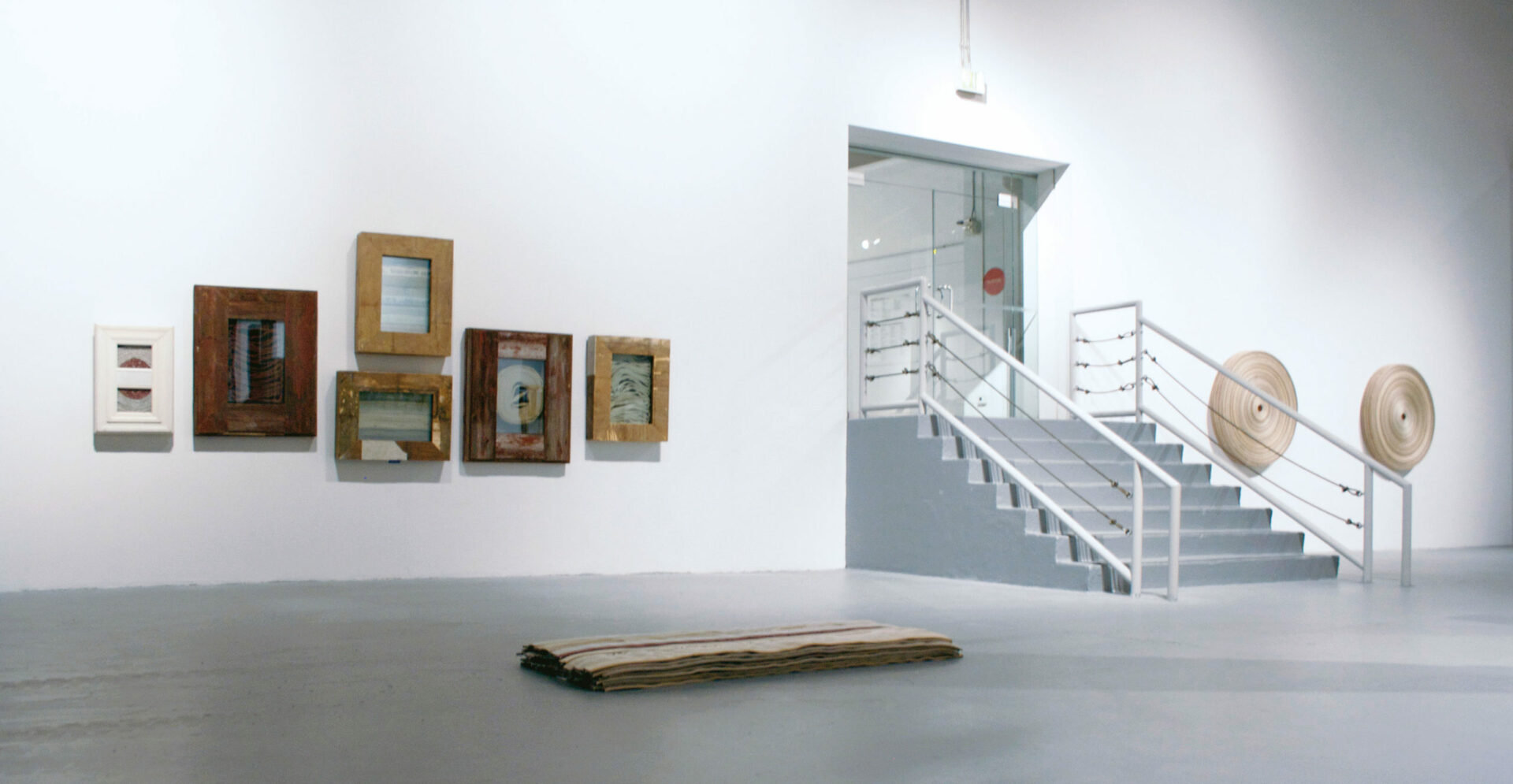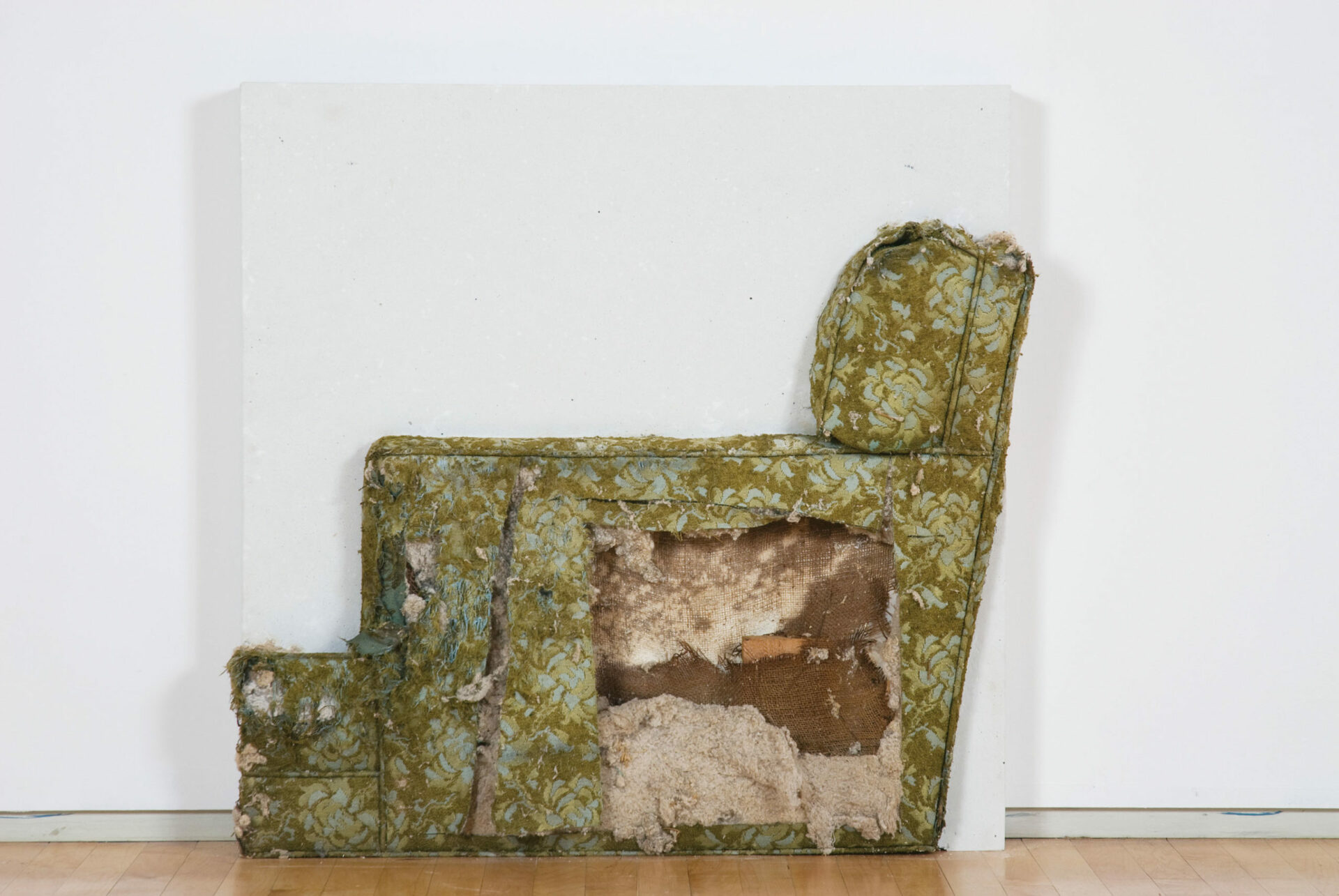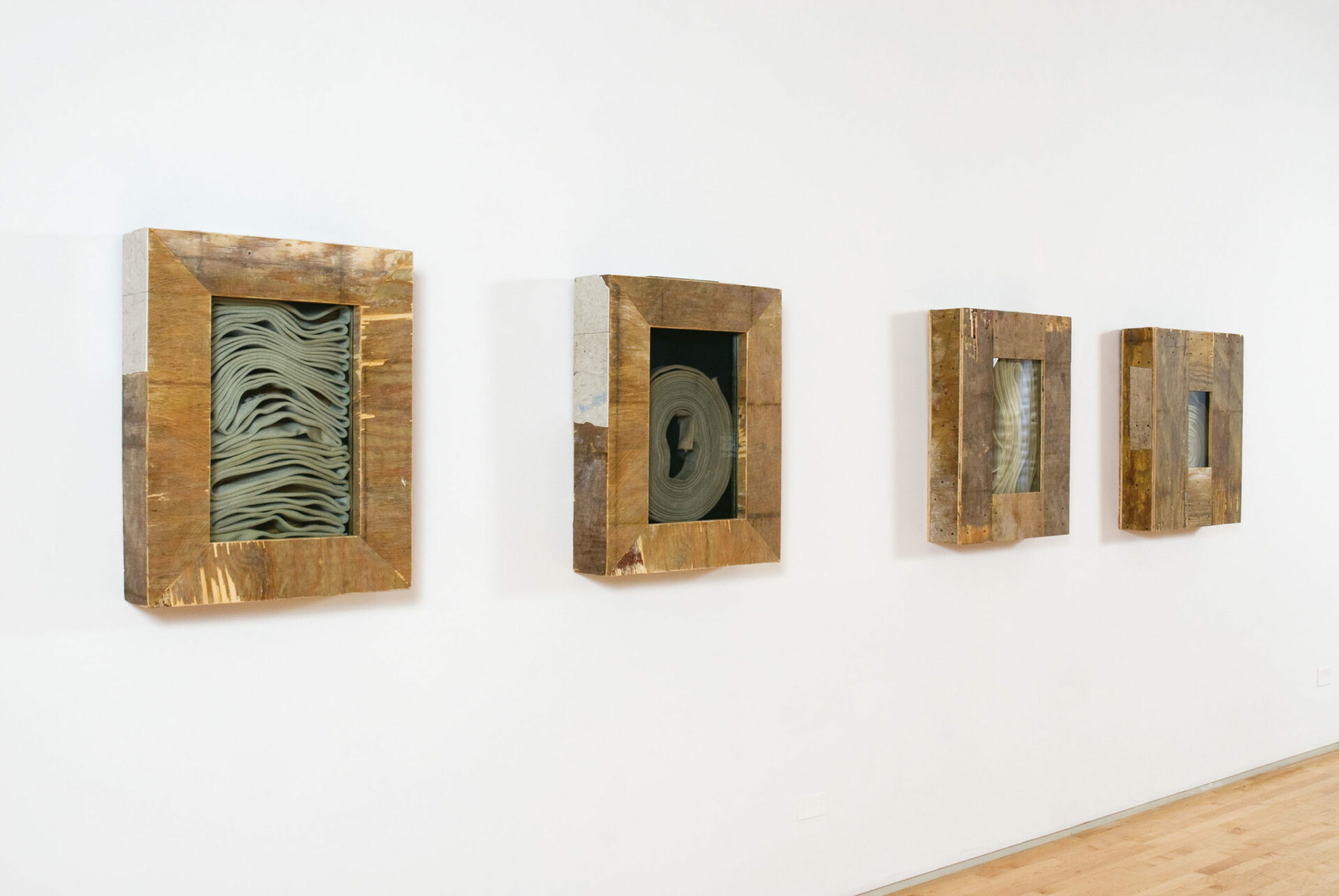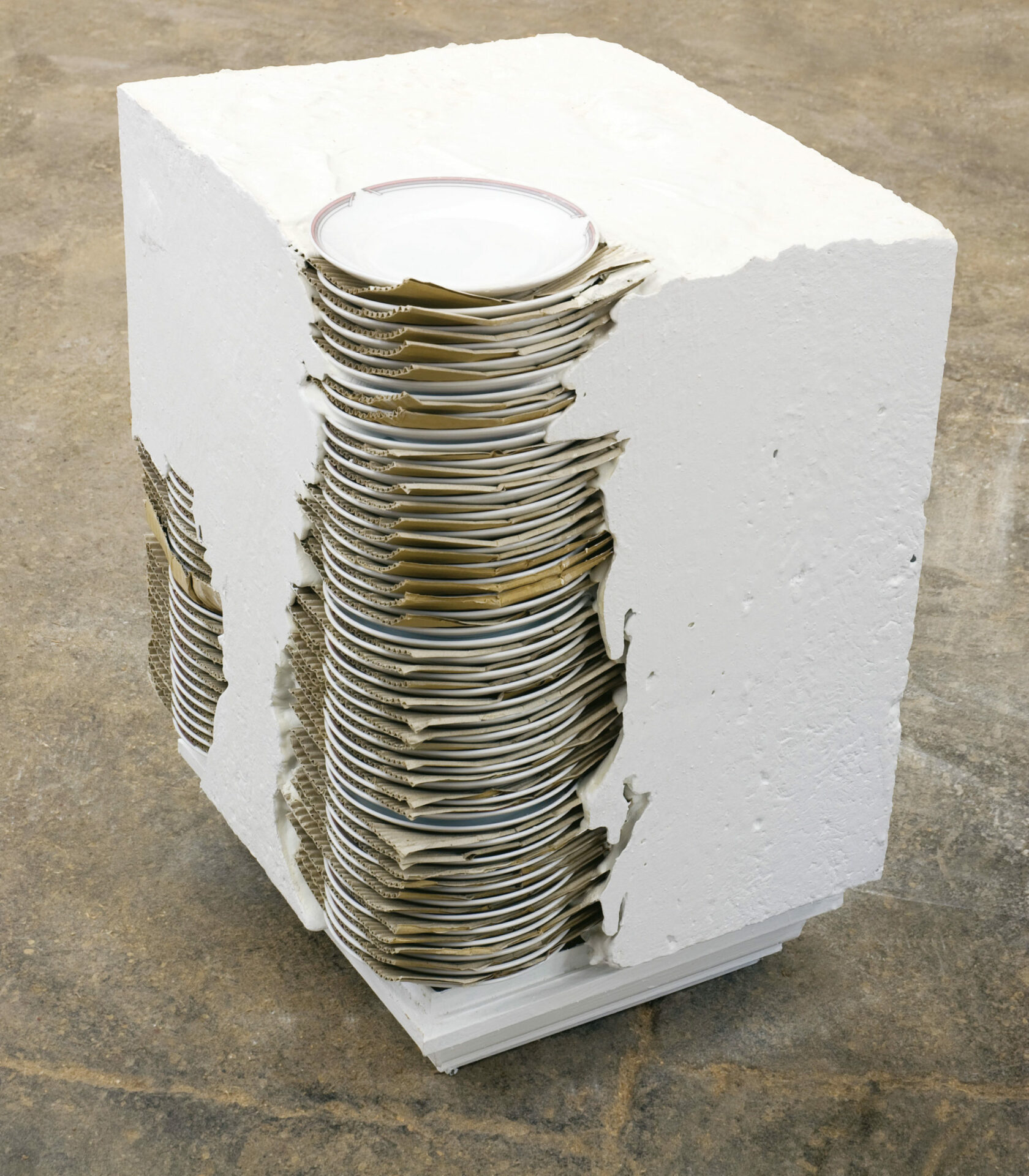
photo : permission de | courtesy of Kavi Gupta Gallery, Chicago
Trained as a ceramicist and with degrees in both Urban Planning and Religious Studies, the Chicago-based artist Theaster Gates has developed a hybridized practice combining elements of contemporary art, urban planning, and community activism. An implicit curatorial impulse drives Gates’ practice, from his object-based works to his social projects. The artist draws liberally from his immediate surroundings to create his sculptural and installation works — which often engage black history and iconography — and invests the funds from the sale of these works back into the development of socially engaged endeavors like his initiative, The Dorchester Projects, a community centre that includes a library and archive, as well as an ongoing program of performances, dinners, and other events.
Throughout his practice, the artist salvages and appropriates structures as if they are “an architecture waiting to be used.” Gates once used this term in a performance to describe an empty church, yet this metaphor of institutions and history lying in wait to be scavenged and repurposed crops up again and again in his work, whether in a series of sculptures about the legacy of the civil rights movement, performances that evoke the traditions of black churches within the parameters of contemporary art institutions, or The Dorchester Projects, which literally transforms abandoned buildings into viable sites for local cultural production and exchange. While Gates fervently resists being described as a “social worker,” mediation forms the core of his practice. What emerges from the artist’s interdisciplinary approach is not only an economically self-sustainable vision for the intersection of entrepreneurship, social responsibility, and contemporary art, but also a framework for the production, circulation and interrogation of black history and culture.
Theaster Gates’ exhibition at the Los Angeles Museum of Contemporary Art (MOCA) in 2011 — his first museum exhibition on the West Coast — reprises a solo exhibition presented at the Kavi Gupta Gallery in Chicago earlier that same year. Entitled An Epitaph for Civil Rights and Other Domesticated Structures, the exhibition at Kavi Gupta linked the material culture of present day South Side Chicago with the legacy of the Southern Christian Leadership Conference’s 1963 Birmingham Campaign, a demonstration immortalized by photographs of black youth being attacked with high-pressure jet hoses and menaced by dogs after Commissioner for Public Safety “Bull” Conner ordered the use of force against demonstrators.

exhibition view, The Museum of Contemporary Art, Los Angeles, 2011.
photo : permission de | courtesy of Kavi Gupta Gallery, Chicago
Gates describes the objects and performances that comprise the exhibition as a “descent into mourning.”1 1 - “Epitaph for Civil Rights and Other Domesticated Structures,” press release, Kavi Gupta Gallery, April 2011. To this end, he does not mobilize the violent imagery commonly associated with the Birmingham Campaign, but instead utilizes a minimal, formal vocabulary to place loaded historic symbols in conversation with evocative scraps of urban detritus. In his series In the Event of a Race Riot,Gates places decommissioned firehoses into rough-hewn, handmade vitrines. Installed in a serial fashion along the gallery wall, both the form and the title of the work evoke the small, glass-front boxes generally found in schools and municipal buildings. In the event of an emergency, one would break the glass with a small mallet to set off an alarm. Gates mines both the language and iconography of emergency to make an oblique, yet nonetheless potent, statement on the legacy of civil rights in America. The artist’s choice to place this history in conversation with Minimalist forms, which one typically associates with industrial materials, neutrality, the absence of the artist’s hand, and emphatic non-relationality, powerfully reactivates the connections between Minimalism’s formal force and the violence of the 1960s that Anna C. Chave so convincingly explicates in her essay, “Minimalism and the Rhetoric of Power.”
While many of the sculptural and installation works in the exhibition riff on the hallmarks of Minimalism — such as geometric forms, repetitive patterns, and serial structures — Gates purposefully exploits the relational associations of his material, thus subverting Minimalism’s visual language of abstraction and professed neutrality to emotive ends. Two other works in the exhibition, Civil Tapestries and Civil Throw Rug, continue the firehose motif. By naming the works after common decorative household items in this instance, the artist posits the violence associated with the firehoses as a constitutive component of civil and domestic life, a backdrop against which personal histories may unfold. This incursion into the domestic continues in works like Love Seat, a sculpture in which a tattered chair is embedded in cement, and Small Stack, one work in a series of sculptures in which the corners of cement pillars are eroded to reveal stacks of dinner plates. Taken on their own, the works have a stillness that resists easy codification and digestion, while nonetheless juxtaposing intimate, yet anonymous, symbols of urban blight, alongside equally ambiguous, yet nonetheless succinct, references to systematic violence directed against black bodies.


Theaster Gates, An Epitaph for Civil Rights and Other Domesticated Structures, 2011.
photos : permission de | courtesy of Kavi Gupta Gallery, Chicago
Though his work resists conscription into a solely black representational space, Gates clearly draws upon the aesthetic, material, and social history of blacks in the United States.2 2 - For the origins of discussions about “post-blackness,” see Thelma Golden in the exhibition catalogue Freestyle (New York: Studio Museum, 2001) and Darbie English, How to See a Work of Art in Total Darkness (Cambridge: MIT Press, 2007). Could the relationships that Gates posits — between different time periods, between his discrete, yet interconnected bodies of work, and between cultural specificity and willful generalizations — somehow posit a relational, rather than rooted reading of identity? According to Édouard Glissant’s distinction between rooted and relational identities, a rooted identity is “ratified by a claim to legitimacy that allows a community to proclaim its entitlement to the possession of a land, which thus becomes a territory.”3 3 - Édouard Glissant, The Poetics of Relation (Ann Arbor: The University of Michigan Press, 1997), 143. A relational identity, on the other hand, “does not devise any legitimacy as its guarantee of entitlement, but circulates, newly extended” and “does not think of a land as a territory from which to project toward other territories but as a place where one gives-on-and-with rather than grasps.”4 4 - Ibid, 144. By drawing upon a legacy of incalculable cruelty and violence and portraying it in a formal language that mirrors this monolithic power, it seems that Gates is presenting us with an oppression that forms an irreducible kernel of black identity, the very definition of a rootedness. However, by creating a system in which the sale and display of objects engaging black history benefit black community centres of the artist’s own devising (whose future can only be contingent), Gates creates a dynamic framework that privileges a variegated vision of race in the United States.
Gates also utilizes the medium of performance, in which he adopts the persona of a preacher or master of ceremonies, to activate an expanded dialogical field around his sculptural and installation works. Unlike historical Minimalist sculptors who have described their work’s relationship to the space of exhibition as one of “seizing and holding,” Gates combines sculpture and performance to create a space built on ritual and shared experience, rather than an individual perceptual encounter.5 5 - See Anna C. Chave, “Minimalism and the Rhetoric of Power,” Arts Magazine, 64.5 (January 1990), 44 – 63 and Hal Foster, “The Crux of Minimalism” in The Return of the Real (Cambridge: MIT Press, 1996). “This is like church,” Gates told the audience before closing his eyes and launching into song. Invited by the Los Angeles Museum of Contemporary Art’s director, Jeffrey Deitch, to give an artist’s talk on An Epitaph for Civil Rights in early November 2011, Gates opted to give his talk in the form of a performance with his frequent collaborators, the Black Monks of Mississippi. Gates used song as a means to engage both the conceptual and historical underpinnings of the works on view, as well as to underscore their conditions of production, circulation, and reception. For approximately one hour, Gates sang with the group, interspersing songs and guttural improvisations with musings on architecture, civil rights, and the art market. He sang about protest, the artistic process, and fights with art dealers and curators who didn’t understand his work, calling to attention the various structures that contribute to the meaning of his work conceptually and the confluence of forces that frame the contextualization of his work through display.
In this exhibition, like the exhibition at Kavi Gupta in Chicago and its accompanying performance, Gates activates the language of sorrow and redemption, as well as specificities of black American history. While his object-based works are devoid of religious references, he utilizes the format of performance in each exhibition context to create a shared experience that riffs on the dynamics of black church services. However, Gates posits these poles of religious and cultural experience as rough markers to work within, building an architecture of experience that creates an opportunity to transcend cultural, religious, and medium specificity.

photo : permission de | courtesy
of Kavi Gupta Gallery, Chicago
In his MOCA performance, he embodied the role of the preacher-MC, invoking an element of ritual that, while not directly borrowed from a specific black church, is certainly inspired by them generally. Not only is the MC or preacher a significant performative role that enables Gates to activate expanded histories and contexts to read his object-based work, but the role carries throughout his artistic practice as a conceptual stance. Gates says:
“What’s really clear and concrete is the role that ritual plays, and the way that religious orders have kind of canonized certain kinds of movements, gestures, ceremonies, or a particular kind of brotherhood or sisterhood, in the name of God. But really it’s about the rituals that people perform everyday — the everyday rituals of religion and the weekly rituals of a black preacher. Because I saw them so much and I understand the mechanisms, it’s hard to get away from those rituals having an impact on any set of things I make.”6 6 - Abraham Ritchie, “The Slant on Theaster Gates,” Artslant (May 2010), accessed December 9, 2011, www.artslant.com/global/artists/rackroom/33623-theaster-gates.
In approaching performance in this way, Gates uses his objects to frame his performance and his performances to weave additional relational webs around his objects, as if he were anointing it with a sort of ritualistic force. In his performance at the Museum of Contemporary Art (MOCA) in Los Angeles, the artist described the feeling of an empty church, contrasting its physical form with its symbolic weight. The reverence and desire that a congregation brings with it to worship animates this structure, just as the expectation a viewer brings to an exhibition space will activate the work within it. When empty, a church, like a museum, is simply an “architecture waiting to be used”: a site of possibility.
